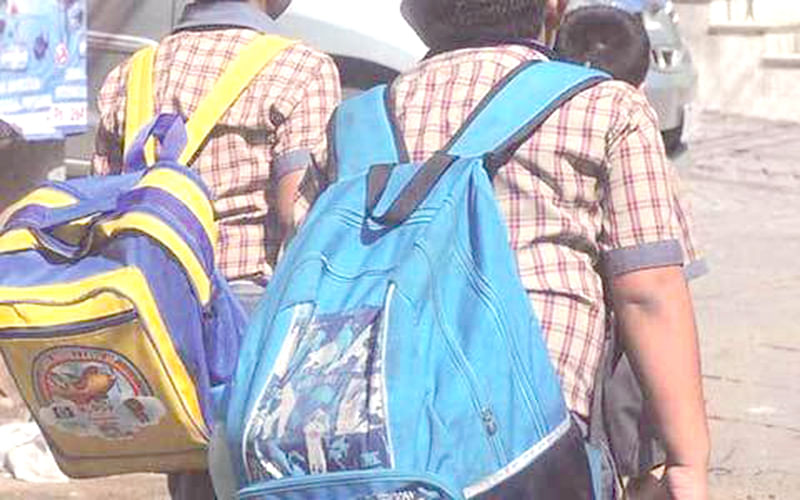If one tries to visualise the schooling process in the present times, one sees an image of a child with a bag on the shoulder. The very posture and face expression reflect that the bag is very heavy for the child. Eminent writer R K Narayan has drawn the country’s attention to this sight by making a moving speech in the Rajya Sabha ( Yeshpal Committee report, MHRD 1993).
This concern was also discussed during the framing of National Curriculum Framework for School Education (NCFSE 2000) and National Curriculum Framework (NCF 2005). NCF 2005 draws its insight from the report learning without burden 1993, which indicates that the school bag as a source of physical discomfort, besides load of non- comprehension.
Many states and UTs have taken some initiatives to address issues related to heavy school bags, such as creating semester system in schools (Tamil Nadu) and locker system in schools for keeping textbooks (few kendriya vidyaliyas). The state of Telangana and Maharashtra have also circulated guidelines on school bags.
Honourable High Court of jurisdiction at Madras in its judgement dated 19.05.2018 in M. Proshotum Vs Union of India has directed the Union of India to formulate a policy on the lines of Children School Bag Bill 2006. In view of the above, MoE decided to constitute an expert group to look into the matter.
The expert group members met four times to pool their experiences. They also shared and discussed guidelines, bills and reports developed by various states and agencies on the reduction of heavy school bags to formulate a strategy for developing the draft policy. Based on this discussion and survey of related literature, the issues related to weight of school bag as enshrined in the policy are discussed as:
The group decided to conduct a brief survey of schools and get data for analysis of issues regarding school bag. 352 schools including vidyaliyas and state run government schools, 3624 students, 2992 parents responded in the survey.
Findings of the survey
1) The school bag for primary classes weighs between 2-3 Kgs, which is more than the permissible weight. From classes 6th, weight of the school bag further increases (3-6kgs) which exceeds the internationally accepted limit of 10 % of body weight. Items found contributing to excessive load are:
- Textbooks
- Notebook
- Lunchbox
- Water bottle
- Reference books from classes 8th onwards.
The weight of empty school bag was also found to be varying from 150gms to 1 kg
- 77 % school heads say that besides textbooks, the students carry lunch pack, water bottles or drinks, notebooks, science and math kits.
- Majority of schools reported that students though drink potable water at school, yet they carry water bottles with them.
- 40% of the school heads think that handling school bags is a problem for the students.
Recommendation for the reduction of weight of school bag .
- School management shall provide good quality potable water in sufficient quantity to students to avoid carrying water bottle.
- Children with special needs (CWSN) can be provided double set of textbooks.
- Lockers may be installed in schools and classes for storing and retrieving books and other items.
- For selecting a textbook for children, the criterion of weight should be taken into consideration. Weight of text book may be printed on the text book along with GSM.
- Use of weighing machine to check the weight of school bags.
- No reference book shall be allowed to be carried to school; instead schools shall arrange book banks and libraries for the same.
- Practice of having one notebook for all subjects especially for lower primary classes.
Guidelines for reduction of school bag weight:
Body weight and weight of school bag.
| S.No. | Class | Average body wt.(kgs) | Bag weight(kgs) Recommended |
| 1. | Pre pry. | 10-16 | No Bag |
| 2. | 1st. | 16-22 | 1.6-2.2 |
| 3. | 2nd. | 16-22 | 1.6-2.2 |
| 4. | 3rd. | 17-25 | 1.7-2.5 |
| 5. | 4th. | 17-25 | 1.7-2.5 |
| 6. | 5th. | 17-25 | 1.7-2.5 |
| 7. | 6th. | 20-30 | 2-3 |
| 8. | 7th. | 20-30 | 2-3 |
| 9. | 8th. | 25-40 | 2.5-4 |
| 10. | 9th. | 25-40 | 2.5-4 |
| 11. | 10th. | 25-45 | 2.5-4.5 |
Weight of textbooks developed by NCERT
| S. No. | Class | No. of textbooks | Total weight (in gms) | No. of Subjects. |
| 1. | 1st. | 3 | 1078 | 3 |
| 2. | 2nd. | 3 | 1080 | 3 |
| 3. | 3rd. | 4 | 1572 | 4 |
| 4. | 4th. | 4 | 1804 | 4 |
| 5. | 5th. | 4 | 1916 | 4 |
| 6. | 6th. | 10 | 3080 | 6 |
| 7. | 7th. | 10 | 3508 | 6 |
| 8. | 8th. | 11 | 3640 | 6 |
| 9. | 9th. | 15 | 4400 | 6 |
| 10. | 10th. | 13 | 4182 | 6 |
NCERT/SCERTs need to come up with Text Book Development policy which clearly enumerates minimum and maximum range of pages and weight of text book for each class across subject. Teacher Training Institutions need to develop awareness modules for the training of teachers, Teacher Educators and other stakeholders on issues related to school bag, homework etc.
(Author is Lecturer at DIET Sopore Baramulla)






